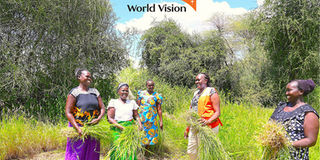How a cost-effective, tree-based initiative is helping communities in Kenya to defeat droughts
Sponsored by World Vision Kenya

By Emily Ouko, Environmental Conservation Specialist, World Vision Kenya
Year in, year out, many Kenyan communities grapple with food insecurity challenges as a result of persistent droughts or long dry spells, exacerbated by climate change.
This challenge, coupled with rapid land degradation resulting from the destruction of trees (in forests, farmlands, and grazing lands) have diminished crop productivity and pasture availability, which are the bedrock of survival for a majority of Kenyan communities.
Agriculture is key to Kenya's development. The sector accounts for 23 percent of the total value of the country's economy, based on the 2021 Kenya Economic Survey. It is also the mainstay of rural communities that constitute close to 70 percent of the country's population, as per the national census conducted in 2019.
These people rely heavily on the productivity of farmlands, grazing lands, as well as forests, for their food supply, health, and income.
Consequently, the gruelling effects of climate-change-induced droughts, coupled with unsustainable land use practices, as well as land degradation linked to deforestation, are pushing communities into poverty, while putting the lives and well-being of millions of children and families at risk.
The effects are widespread and intense. Families continue to face perpetual hunger, which is taking a toll on children due to the ravishing impacts of malnutrition that impedes their optimal development and health.
Because of these effects, many parents are also unable to adequately cater for their basic needs due to loss of livelihood. This makes children drop out of school and become vulnerable to various forms of abuse, including child labour and Female Genital Mutilation (FGM).
The magnitude of the problem is enormous. However, these challenges are surmountable, as already demonstrated in some parts of the country.
Through an innovative reforestation and land restoration initiative known as the Farmer Managed Natural Regeneration (FMNR) approach, affected rural communities are increasingly becoming resilient to climate-change-induced risks like droughts, and are finding ways to overcome or effectively cope with their harrowing effects.
With support from GIZ, World Vision, in partnership with the government and other stakeholders, has been promoting this low-cost FMNR technique in various parts of Kenya, Including Baringo, Migori, Marsabit, Isiolo, Nakuru, Homa Bay, West Pokot, and Elgeyo Marakwet, to improve livelihoods and build the resilience of rural communities to climate-change-induced droughts.
The FMNR technique enables farmers to increase tree cover on their land by boosting the regrowth of indigenous trees from felled stumps or roots of previously cut trees, as well as from naturally occurring tree seedlings present in the soil or on farms.
It also enables farmers to systematically manage upcoming trees as well as those already existing, through pruning and protection against damage by animals.
Increased tree populations within farms come with immense benefits for farmers. First, they help to restore degraded lands, thereby boosting soil fertility and agricultural productivity. This translates into bumper harvests and improved household food security, which enable families to have sufficient food for consumption and income generation all year round, even in times of drought.
Trees also provide a conducive environment for the robust growth of grass that farmers are able to harvest and store as hay for use during long periods of drought.
In addition, the barks and pods of some indigenous trees act as direct sources of nutritious fodder that can sustain livestock during long dry spells. Examples include acacia trees that can survive the harsh climatic conditions in arid and semi-arid areas. They usually remain standing long after other types of vegetation have dried up during the drought.
Having trees on farms has also opened up alternative livelihood streams for communities that have embraced the FMNR approach.
Since bees thrive in areas surrounded by trees, many have taken up beekeeping, which allows them to reap profits from honey and honey-based products.
From the branches cut when the trees are being pruned, communities are also able to make charcoal or get firewood for cooking at home as well as for sale. These ventures provide them with additional income.
An assessment by World Vision in parts of Baringo three years after the FMNR approach was introduced to communities, revealed that the number of trees per acre increased from a median of nine in 2013 to 30 by 2016.
Over 40 percent of farmers that had begun embracing the technique reported an increase in crop production as a result of growing crops alongside trees. They also indicated that they made additional income from tree and non-tree-based products such as charcoal, firewood, fruits, pasture, beekeeping, and medicine from medicinal trees.
These families were able to adequately take care of their children and improve their well-being through an adequate supply of nutritious foods that kept them healthy. They could also afford to give the children quality education, health care, good housing, and clothing.
Having trees on home farms has also helped to reduce pressure on forests, whose survival is increasingly being threatened by deforestation as people cut down many trees for charcoal and firewood.
In Migori County, for instance, the Mirema forest, which had been destroyed, is slowly coming to life after the FMNR approach, together with other re-greening initiatives, were introduced in the area. About 50 percent of the forest land, which was initially bare and dry, is currently covered with trees. Consequently, families living around the forest note that they now receive adequate rainfall quantities than they previously got.
These impact stories are a true testament to the power that increased tree cover, made possible through the FMNR approach, can play in helping communities to mitigate climate change and become resilient to the devastating effects of perennial drought caused by global warming.


